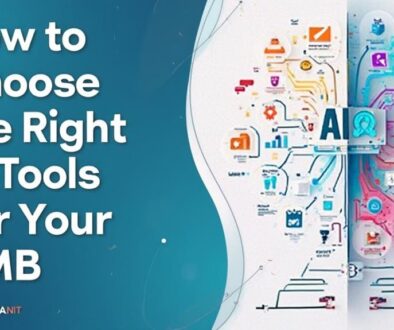The Benefits of AI-Driven Decision Making for SMBs
AI-driven decision-making provides SMBs with a multitude of benefits, including enhanced data analysis, improved customer insights, and streamlined operations. By utilizing advanced analytics, businesses gain deeper understanding of market trends and customer preferences, enabling tailored marketing strategies. Additionally, AI optimizes resource allocation and workflow efficiency, reducing operational bottlenecks and driving productivity. Better risk management and cost efficiency further position SMBs to navigate market challenges effectively. Ultimately, these advantages can lead to a significant competitive edge, empowering SMBs to respond agilely to evolving market demands. Exploring these aspects can reveal additional insights that drive strategic growth.
Key Takeaways
- AI-driven decision-making enhances strategic choices by efficiently handling complex data for SMBs, leading to better outcomes.
- Real-time data analysis allows SMBs to identify trends and anomalies swiftly, capitalizing on emerging opportunities.
- Predictive analytics empowers SMBs to optimize inventory and marketing strategies through insights derived from historical data.
- Enhanced data visualization transforms raw information into intuitive insights, fostering a better understanding of market conditions.
- AI tools improve operational efficiency, helping SMBs streamline processes and enhance productivity across various functions.
Enhanced Data Analysis

Enhanced data analysis is a cornerstone of AI-driven decision-making for small and medium-sized businesses (SMBs), enabling these organizations to harness large volumes of data with unprecedented efficiency. By leveraging advanced data visualization techniques, SMBs can distill complex datasets into intuitive and actionable insights. This approach not only facilitates comprehension but also empowers decision-makers to quickly identify trends, correlations, and anomalies that may otherwise remain obscured.
The integration of machine learning algorithms further amplifies the analytical capabilities of SMBs. These algorithms can process historical data and predict future outcomes, allowing businesses to make informed strategic choices with greater accuracy. For example, machine learning models can analyze purchasing patterns and customer behaviors, leading to optimized inventory management and improved marketing strategies. The adaptability of these algorithms guarantees that as new data flows in, insights remain relevant and timely.
SMBs can implement various data visualization techniques, such as interactive dashboards and heat maps, to present findings in an engaging manner. This transforms data from static reports into dynamic visual experiences, encouraging collaboration across departments and fostering a culture of data-driven decision-making.
Improved Customer Insights
AI technologies enable small and medium-sized businesses (SMBs) to transform raw data into actionable customer insights, enhancing data analysis capabilities.
By identifying predictive behavior trends, companies can anticipate customer needs and preferences, leading to more effective engagement strategies.
Additionally, these insights facilitate the development of personalized marketing approaches that resonate with individual consumer segments, ultimately driving loyalty and increasing sales.
Enhanced Data Analysis
Leveraging advanced data analytics has become a pivotal strategy for small and medium-sized businesses (SMBs) seeking to gain deeper insights into customer behavior and preferences. By utilizing cutting-edge tools and techniques, SMBs can enhance data analysis, allowing for improved decision-making processes rooted in solid evidence.
- Data Visualization: Transforming complex data into visual formats helps SMBs easily interpret information, enabling quicker identification of patterns and customer trends.
- Trend Identification: Analyzing historical data aids in recognizing emerging trends, offering businesses a competitive edge in understanding shifting customer demands.
- Segmentation Analysis: By categorizing customers based on behavior, SMBs can tailor marketing campaigns effectively, fostering a more personalized customer experience.
- Feedback Analysis: Systematically evaluating customer feedback through analytics uncovers insights that drive product improvements and satisfaction enhancement.
Implementing enhanced data analysis not only empowers SMBs to make informed choices but also positions them to respond proactively to market changes.
Through a combination of data visualization and precise trend identification, businesses can harness the power of data to reveal unprecedented levels of customer understanding. This analytical approach fosters the freedom to innovate and adapt in a rapidly evolving marketplace.
Predictive Behavior Trends
Building upon the foundation of enhanced data analysis, predictive behavior trends offer SMBs a powerful means to refine customer insights further. By leveraging behavioral analytics, businesses can achieve precise customer segmentation, enabling a more tailored approach to engagement.
Understanding behavioral patterns allows SMBs to anticipate market shifts and consumer preferences, wielding trend forecasting as a strategic tool for positioning their offerings.
With thorough demographic insights, companies can predict sales with greater accuracy, optimizing inventory management and resource allocation. The application of data-driven strategies enhances user engagement, fostering a dynamic connection between the business and its customers.
Aligning marketing efforts with expected consumer behavior, SMBs can harness market anticipation for proactive decision-making.
Moreover, organizations can uncover latent needs within customer segments, driving innovation and product development rooted in actual demand rather than speculation. Such capabilities not only contribute to maintaining competitive advantage but also promote a culture of adaptability and responsiveness.
Fundamentally, by embracing predictive behavior trends, SMBs can transform their operational strategies, mode of engagement, and ultimately, their growth trajectories.
Personalized Marketing Strategies
Personalized marketing strategies are increasingly essential for small and medium-sized businesses (SMBs) aiming to enhance customer engagement and drive conversions.
Leveraging AI tools enables SMBs to refine their approach by gaining deeper insights into customer behavior. This foundational understanding facilitates effective personalization, thereby increasing brand loyalty and optimizing user experience.
Key strategies include:
- Customer Segmentation: Dividing your audience into distinct groups allows for tailored messaging that resonates deeply with each segment.
- Content Personalization: Crafting unique content aligned with customer preferences enhances relevancy and drives engagement metrics.
- Campaign Automation: Automating marketing efforts frees resources while ensuring timely communication, enabling effective audience targeting and lead scoring.
- Multi-Channel Integration: Engaging customers across various platforms fosters a seamless experience, leading to improved conversion optimization.
Streamlined Operations

Streamlined operations are critical for small and medium-sized businesses (SMBs) aiming to enhance productivity and responsiveness.
By implementing AI-driven solutions, organizations can achieve enhanced workflow efficiency, real-time data analysis, and optimized resource allocation.
These advancements not only reduce operational bottlenecks but also empower SMBs to make informed decisions that align with their strategic objectives.
Enhanced Workflow Efficiency
Efficiency is a critical component in the operational success of small and medium-sized businesses (SMBs), as it directly influences productivity and cost-effectiveness.
Leveraging AI technologies can greatly enhance workflow efficiency, leading to streamlined operations that foster growth and innovation.
Key approaches include:
- Automated Task Management: By automating routine tasks, SMBs can reduce time spent on administrative functions, allowing teams to focus on core business activities.
- Intelligent Process Automation: This technology facilitates seamless integration of various business processes, ensuring consistency and accuracy throughout operations.
- Workflow Optimization Tools: These tools provide insights into current workflows, enabling managers to identify bottlenecks and implement necessary changes to enhance performance directly.
- Real-Time Collaboration: AI fosters enhanced communication among team members, driving collaboration that allows for quicker decision-making and aligning team productivity enhancement.
Real-time Data Analysis
As businesses increasingly adopt automated task management and intelligent process automation, the significance of real-time data analysis becomes apparent. This approach empowers small and medium-sized businesses (SMBs) to streamline operations considerably.
By leveraging cutting-edge data visualization tools, organizations can convert complex datasets into easily interpretable formats, facilitating quicker decision-making processes.
Real-time data analysis not only enhances the accuracy of insights but also enables proactive management of daily operations. Automated reporting features eliminate the time-consuming task of manual data collection, providing leaders with immediate access to crucial metrics. This immediacy guarantees that business decisions are made based on the most current information, reducing the risks associated with outdated data.
Moreover, real-time analysis helps identify trends and anomalies as they arise, allowing businesses to capitalize on opportunities or mitigate risks swiftly.
Resource Allocation Optimization
Optimizing resource allocation is essential for small and medium-sized businesses (SMBs) seeking to enhance operational effectiveness and drive sustainable growth. By leveraging AI-driven decision-making tools, SMBs can streamline operations through accurate resource prioritization and improved financial modeling. This allows for more precise budget forecasting and effective capacity planning, ensuring that resources are used where they yield the most value.
Key strategies for resource allocation enhancement include:
- Demand Forecasting: Utilizing AI to predict future needs helps in aligning resources with anticipated market demand.
- Talent Allocation: AI can analyze skill sets and performance metrics, enabling businesses to assign the right people to projects, enhancing productivity.
- Project Assessment: AI-driven analytics assist in evaluating project viability, ensuring informed decisions on resource distribution.
- Asset Management: Effective tracking and management of assets foster ideal utilization, minimizing waste and maximizing return on investment.
Better Risk Management
In the dynamic landscape of small and medium-sized businesses (SMBs), effective risk management is essential for sustained growth and stability. AI-driven decision-making enhances this capability by enabling thorough risk assessment processes that identify vulnerabilities in operations and compliance monitoring. These technologies analyze vast amounts of data with precision, ensuring that vital factors such as data security are prioritized to protect sensitive information against breaches.
One of the most significant advantages of utilizing AI in risk management is its ability to conduct scenario planning. By simulating various market conditions, businesses can better prepare for potential risks associated with market volatility. This proactive approach helps SMBs to craft robust decision frameworks that not only mitigate risks but also leverage opportunities for growth.
AI also plays an important role in financial forecasting, equipping decision-makers with insightful projections relevant to risk. Accurate forecasting allows businesses to make informed decisions regarding investments and resource allocation, while enhancing their operational resilience in the face of unforeseen challenges.
Ultimately, integrating AI into risk management strategies supports SMBs in maintaining compliance with regulatory requirements and maneuvering a complex business environment. By adopting AI-driven tools, these enterprises can foster an agile, responsive organizational culture that thrives amid uncertainties.
Emphasizing better risk management through AI not only protects the business's immediate interests but also positions it for long-term success and freedom from operational constraints.
Cost Efficiency

Leveraging AI technology introduces significant cost efficiency for small and medium-sized businesses (SMBs) by streamlining operations and reducing overhead expenses. The integration of AI tools allows SMBs to achieve unparalleled financial oversight and management, which fosters enhanced resource effectiveness.
One key area where AI proves invaluable is automated budgeting. By utilizing smart algorithms, businesses can generate precise budgets that reflect real-time data, thereby minimizing inaccuracies and inefficiencies.
Moreover, effective expense tracking powered by AI helps in identifying unnecessary expenditures and mitigating waste, leading to significant cost reduction.
In addition, AI's capabilities in financial forecasting enable SMBs to anticipate market trends, allowing for informed decision-making regarding investments and resource allocation. Through detailed investment analysis, companies can prioritize high-return opportunities while avoiding less profitable ventures.
This degree of scrutiny facilitates operational savings as resources are reallocated towards more fruitful projects. Overall, incorporating AI solutions in expenditure management provides SMBs with the ability to control and reduce costs effectively.
Key aspects of cost efficiency through AI technology include:
- Automated budgeting: Creates accurate budgets swiftly, reducing human errors.
- Expense tracking: Monitors spending patterns to identify and cut unnecessary costs.
- Financial forecasting: Provides insights into future financial conditions for better planning.
- Investment analysis: Evaluates potential investments to guarantee ideal use of resources.
In this manner, AI-driven decision-making solidifies the foundation of financially sound operations, enhancing the potential for growth and longevity in a competitive landscape.
Competitive Advantage
Harnessing the power of AI technology can greatly enhance the competitive advantage of small and medium-sized businesses (SMBs) in today's dynamic marketplace. By integrating AI into their operations, SMBs can markedly improve their strategic planning and market positioning. AI integration facilitates data-driven decision frameworks that optimize operational effectiveness, leading to enhanced productivity and resource allocation.
Through technology investment, SMBs can employ advanced analytics for trend analysis, allowing them to identify market shifts and consumer preferences with remarkable agility. This timely insight fosters innovation adoption, enabling businesses to pivot rapidly in response to new opportunities or challenges. As a result, SMBs can not only remain competitive but often lead in their respective markets.
Additionally, the application of competitive intelligence derived from AI enhances SMBs' ability to benchmark against competitors, identify gaps in the market, and pursue niche segments that may have been overlooked. This insight empowers businesses to craft unique value propositions and tailor their offerings, thereby solidifying their niche in a crowded marketplace.
Moreover, the agility enhancement provided by AI technologies means that SMBs can experiment with new ideas and processes without the fear of crippling costs or considerable risk. Embracing AI-driven decision-making equips organizations with the tools needed to stay ahead, creating a robust foundation for sustained growth and success.
As SMBs continue to leverage AI, their competitive advantage will not only define their current success but also shape their future in an increasingly digital landscape.
Frequently Asked Questions
How Can SMBS Get Started With Ai-Powered Tools?
To commence on integrating AI-powered tools, small and medium-sized businesses (SMBs) should first assess their specific needs and objectives.
Data integration is essential; guaranteeing seamless consolidation of existing data sources will enhance the effectiveness of AI applications.
Subsequently, tool selection becomes vital. Businesses should evaluate various AI solutions, focusing on adaptability and user-friendliness, to make certain they align with operational goals while preserving organizational flexibility and autonomy in decision-making processes.
What Are the Costs Associated With Implementing AI in Smbs?
The costs associated with implementing AI in small and medium-sized businesses (SMBs) encompass several components.
Initial implementation expenses include software acquisition, training, and infrastructure upgrades.
Additionally, ongoing maintenance costs must be considered, such as subscription fees for cloud services, regular system updates, and continuous staff training to guarantee effective utilization.
Is Training Required for Staff to Use AI Effectively?
Effective utilization of AI in organizations necessitates thorough staff training focused on enhancing AI literacy.
Employees must be equipped with the necessary skills to interpret and implement AI tools effectively.
Training programs should emphasize practical applications and ethical considerations, ensuring that staff understand both the technology and its implications.
What Industries Benefit Most From Ai-Driven Decision Making?
Industries immersed in rapid technological evolution are reaping significant advantages from AI-driven decision making.
In healthcare advancements, precision diagnostics emerge, while retail optimization enhances customer experiences and inventory management.
Manufacturing efficiency is revolutionized through predictive maintenance, reducing downtime.
Financial forecasting becomes more accurate, empowering businesses to navigate market volatility.
Additionally, refined marketing strategies enable companies to personalize customer engagement, driving growth.
Each sector exemplifies how embracing AI can reveal unparalleled opportunities and innovation.
Can AI Decision Making Be Customized for Specific Business Needs?
Yes, AI decision-making can indeed be customized to meet specific business needs. By developing custom algorithms, organizations can create tailored solutions that address unique operational challenges.
This adaptability allows businesses to leverage AI in a manner that aligns with their strategic goals and industry requirements. Implementing bespoke AI systems enhances decision-making effectiveness, fosters innovation, and ultimately contributes to a competitive advantage.
This enables firms to navigate the complexities of today's dynamic market landscape.
Conclusion
To sum up, the integration of AI-driven decision-making within small and medium-sized businesses serves as a modern-day oracle, offering profound insights and efficiencies akin to the legendary Rosetta Stone, which deciphered the complexities of human communication. By harnessing enhanced data analysis, improved customer insights, streamlined operations, better risk management, and cost efficiency, these businesses position themselves to not only survive but thrive amidst competitive pressures. Embracing this technological evolution is essential for sustainable growth and market relevance.




